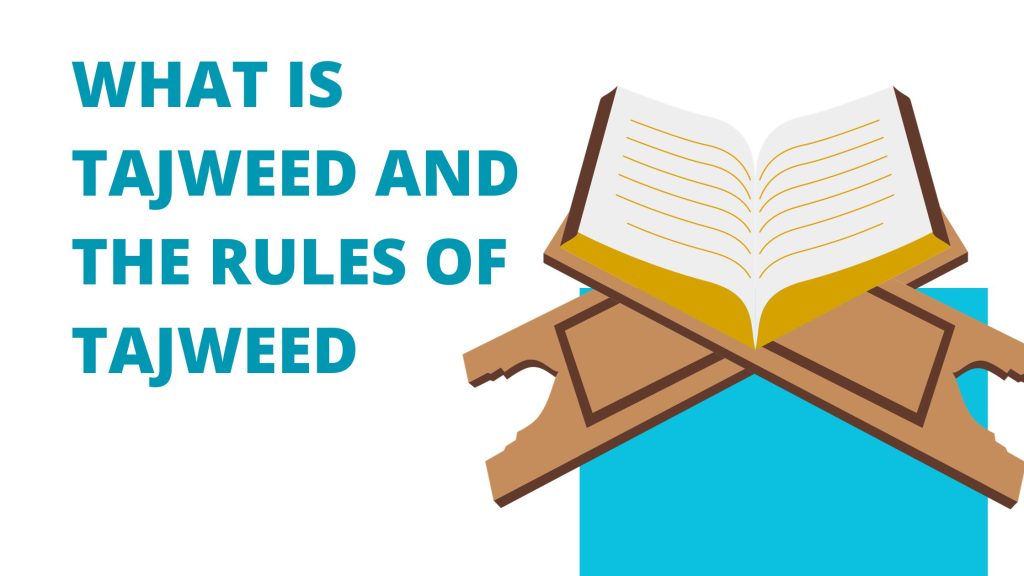Tajweed is an Islamic science that allows you to recite the Quran properly and beautifully like prophet Muhammed’s (PBUH) recitation. You can learn it at home easily through online courses with highly qualified teachers.
Understanding and applying the rules of Tajweed is crucial for every Muslim reciting the Quran, ensuring correct pronunciation, clarity, and proper emphasis on letters and words. These rules encompass various aspects, such as Isti’athah and Basmalah, Noon Saakin and Tanween, Ikhfaa and Idgham, as well as rules governing the pronunciation of Meem Saakinah and Laam Shamsyiah and Qamaryiah.
Additionally, rules like Qalqalah, distinguishing between heavy and light letters, and various types of prolongation (Al-Madd) further refine the recitation, adding beauty and precision.
Read Also: How to Learn And Improve Your Tajweed?
In this blog post, we will explore what Tajweed is and delve into its rules that can transform your recitation into a melodious symphony.
Unlock the beauty of Quranic recitation with Tajweed, the art of perfecting the pronunciation and articulation of every letter.
Whether you are a beginner or an experienced reader, mastering Tajweed is essential for enhancing your understanding and connection to the divine words. So, grab your Quran, and let us embark on this enlightening journey together!
Table of Contents
Definition of Tajweed
Tajweed is the science of recitation in Quranic Arabic, which focuses on perfecting the pronunciation, articulation, and intonation of each letter and word. It ensures that the words are recited with proper clarity and beauty.
Tajweed, derived from the Arabic word “j-w-d,” meaning improvement or embellishment, is an art form that elevates Quranic recitation to a new level.
Tajweed goes beyond mere pronunciation and dives deep into the correct articulation of each letter, considering various aspects such as intonation and rhythm.
If you look up the origins of tajweed as a term, you’ll find this word is derived from “Judah”. It’s an Arabic word that means “quality”.
The linguistic definition of tajweed’s meaning is “beautifying”, “improving”, or “perfecting”.
Read: How Many Rules of Tajweed Are There With Examples.
History of Tajweed
The history of Tajweed traces back to the time of Prophet Muhammad (peace be upon him) himself. Known for his captivating recitation style, he set the standard for how the Quran should be beautifully recited.
These noble teachings were then meticulously preserved and passed down through generations, ensuring that we can still benefit from them today.
The scholars were interested in writing tajweed rules in the third century of Hijra, after the Islamic state’s expansion. This period witnessed several mistakes from Muslims in reciting the Quran. These errors increased due to the difference in languages and dialects of non-Arab Muslims.
The science of tajweed existed practically at the time of the prophet Muhammed (PBUH). But after his death and the Islamic state’s expansion, the scholars started to write the rules of tajweed to establish it theoretically.
Al Khalil bin Ahmad Al-Farahidi was the founder of tajweed science. He was the first scholar who set its rules.

Understanding the Rules of Tajweed
Learning and applying the rules of Tajweed is crucial for every Muslim who wishes to recite the Quran in a beautiful and melodious manner.
The following rules provide a framework that ensures correct pronunciation, clarity, and proper emphasis on letters and words while reciting the holy Quran.
Join BayanalQuran’s online Tajweed classes to deepen your understanding and application of the rules of Tajweed.
Read: Do I have To learn Tajweed?
1. Understanding Isti’athah and Basmalah
Isti’athah refers to seeking refuge with Allah from Shaytan, while Basmalah refers to reciting “Bismillahir Rahmanir Rahim” which translates as “In the name of Allah, the Most Gracious, the Most Merciful.”
When it comes to Tajweed, one of the key aspects to understand is Isti’athah and Basmalah. These two terms are often used at the beginning of recitations and hold significant importance in maintaining proper pronunciation.
By starting our recitations with Isti’athah and Basmalah, we acknowledge that we are seeking protection from any distractions or negative influences during our engagement with the words of Allah.
It sets a tone of reverence and mindfulness for our connection with His divine message. So, let’s remember this important practice as we embark on our journey to learn Tajweed!
Read: The Books of Tajweed.
2. The Rules of Noon Saakin and Tanween
The rules of Noon Saakin and Tanween govern the correct pronunciation and elongation of the letter Noon when it is silent or followed by a vowel sound.
Whether you’re reciting the Quran or reading any other Arabic text, understanding these rules will help you produce clear and accurate sounds.
3. Ikhfaa and Idgham Rules
When encountering Noon Saakin, which is silent noon with no vowel following it, we must observe two important principles:
1. Ikhfaa
Ikhfaa means concealing the sound of the noon slightly so that it is not pronounced as strongly as ordinary noon.
2. Idgham
Idgham involves merging or assimilating the sound of noon into another letter when certain conditions are met. This results in a smooth transition between letters without pausing or stopping in between.
4. The three main rules of Tanween
Tanween refers to adding a short “n” sound at the end of words ending in vowels like -un, -an, and -in. When pronouncing words with Tanween correctly, we need to pay attention to three main rules:
1. Izhar (clearly pronouncing tanween)
2. Iqlab (changing tanween into ‘m’ sound)
3. Idgham (merging tanween into the next consonant).
Each rule has specific conditions based on surrounding letters that determine how Tanween should be pronounced.
By mastering these concepts online through Bayanulquran, individuals around the world can improve their tajweed skills effectively with ease.
5. The Rules of Meem Saakinah
There are two rules that govern the pronunciation of Meem Saakinah:
1. Izhaar
In Izhaar, the Meem should be pronounced with clarity by fully opening the lips and allowing air to pass through without any nasal sound.
2. Idghaam
In Idghaam, when a Meem Saakinah is followed by another letter from the same category (Ba, Ya, or Waw), we blend them smoothly without pronouncing the Meem separately.
This blending creates a nasal sound known as “Nun Ghunnah.” Mastering these rules ensures that our recitation is precise and melodious!
The Rules of Meem Saakinah is an essential aspect of Tajweed that every student must master. When encountering a Meem Saakinah, we need to pay attention to how it is pronounced correctly.
6. The Rules of Laam Shamsyiah and Qamaryiah
Laam Shamsyiah and Qamaryiah are two important aspects of Tajweed that play a significant role in the correct pronunciation of Arabic words. Let’s explore each one further:
A. Laam Al Qamariyah
Laam Al Qamariyah, this lunar Laam possesses an enchanting power when accompanied by its 14 companions, forming a hypnotic group named ابغ حجك و خف عقيمه.
They are none other than the illustrious “Lunar Letters,” gracefully interweaving with Laam Al Qamariyah.
- Lunar Letters
Let us uncover the secret repertoire of these letters: ء, ب, غ, ح, ج, ك, و, خ, ف, ع, ق, ي, م, and ه. As if blessed by moonlight, whenever one of these letters follows in the footsteps of the lunar Laam, its pronunciation radiates clarity, echoing with Idh’har.
This clarity arises from their distant rendezvous, as the exit point of the Laam gracefully retreats from the other lunar letters, creating an ethereal space between them.
B. Laam Ash Shamsiyah
Laam Ash Shamsiyah, also known as Solar Laam, is used to make an indefinite noun definite. It consists of a lam sakina with a hamzah preceding it, which always carries a Fat’ha. When pronouncing الشّمس, it is pronounced as أشمس.
- Solar Letters
The 14 letters that can follow the laam are: ط ث ص ر ت ض ذ ن د س ظ ز ش ل.
When the laam is followed by any of these letters, it must merge without nasalization, which is referred to as “solar Idgham” or merging.
Understanding and implementing these rules is crucial as it helps in maintaining proper flow and rhythm while reciting Quranic verses.
By mastering Laam Shamsyiah and Qamaryiah, learners can enhance their overall recitation skills, ensuring they adhere to the principles of Tajweed!
7. The Rules of Qalqalah
Qalqalah refers to the echoing or bouncing sound produced when pronouncing certain letters with a slight emphasis.
The word “Qalqalah” itself means “echo” in Arabic, perfectly capturing the essence of this rule.
Qalqalah Letters
When reciting letters such as Qaf, Taa, Baa, Jeem, and Daad (ق ط ب ج د), you give them an extra push or bounce while still maintaining their correct pronunciation. This creates a beautiful harmony in your recitation and adds depth to your voice.
Qalqalah Application
Mastering Qalqalah requires practice and precision. You need to strike a balance between producing enough force for the echo effect without distorting the letter’s sound too much.
By incorporating Qalqalah into your recitation, you not only enhance your connection with the words of Allah but also add an artistic touch that makes your recitation truly mesmerizing.
8. The Rules of Heavy and Light Letters
Heavy and Light Letters play a significant role in the beautiful recitation of the Quran. But what exactly are these terms? Well, let’s break it down!
1. Heavy Letters
Heavy Letters (also known as “Huroof al-Tafkheem”) are pronounced with more emphasis and strength. These letters include: ض، غ، ط، ق، ظ خ، ص،.
When reciting them, you should feel the weight of these letters on your tongue as they require a stronger articulation.
2. Light Letters
Light Letters (or “Huroof al-Tarqeeq”), which are pronounced with less force and lightness in their sound.
These letters include: ء، ب، ت، ث، ج، ح، د، ذ، ز، س، ش، ع، ف، ك، ل، م، ن، ه، و، ي . They require a softer articulation compared to Heavy Letters.
Heavy and Light Letters Application
Mastering the correct pronunciation of Heavy and Light Letters is crucial for proper recitation of the Quran.
It adds beauty, clarity, and precision to your recitation while maintaining the true essence of Tajweed principles. So, practice diligently to perfect this aspect of Tajweed!
9. Various Types of Prolongation (Al-Madd)
Prolongation (Al-Madd) refers to extending the pronunciation of certain letters within a word. There are different rules and categories for Al-Madd, each with its specific conditions.
There is a fascinating term known as “Madd” in the vast Arabic language that holds great significance. A term that can be translated as “extension” or “prolongation”.
Madd plays a crucial role within Tajweed rules. Certain letters are pronounced with an enchanting elongation of sounds when they are pronounced.
Vowel Marks and Madd Letters
The Arabic script has three short vowel marks, known as harakats: Fatha, Damma, and Kasra. In addition to these vowel marks, three long vowel indicators are present that make the sounds sound longer, resulting in the captivating “Madd” effect.
1. Alif Letter
The mighty alif (ا) swoops in after a fatha, donning its regular form or the alluring alif maqsûra (ى).
2. Ya Letter
Next up is the dazzling ya (ي), gracefully following a kasra to declare its role as the sign of prolongation.
3. Waw Letter
Finally, we have the formidable waw (و), confidently appearing after a damma, leaving no doubt about the elongation it proudly represents.
Many Quranic verses use long vowel indicators, demonstrating their profound influence on Arabic phonetics and pronunciation.
Categories of Prolongations
Tajweed has two primary categories of prolongations:
1. Natural Prolongations (al Madd al Asli)
2. Conditional Prolongations (al Madd al far’ee).
Each category further branches out into subcategories, creating a comprehensive system that beautifully guides the correct recitation of the Arabic language.
The Importance of Tajweed
Tajweed, the correct pronunciation and recitation of the Quran, holds immense significance in the Islamic faith:
1. Enhancing the beauty and melodiousness of recitation:
Tajweed, the correct way of reciting the Quran, contributes to the aesthetic aspect of recitation. By following the rules of Tajweed, the reader can create a harmonious and pleasing sound, making the recitation more enjoyable and captivating.
2. Preserving the proper pronunciation and articulation of Arabic letters:
Tajweed ensures that each Arabic letter is pronounced correctly and accurately. This is crucial because the Quran was revealed in Arabic, and each letter carries its unique sound and significance. Following Tajweed prevents any mispronunciations or distortions of the letters, preserving the integrity of the Quranic text.
3. Helping to convey the intended meaning accurately:
The rules of Tajweed are designed to bring out the precise meanings and nuances of the Quranic verses. By adhering to Tajweed, readers can convey the intended messages accurately, ensuring the correct interpretation and understanding of the Quran.
4. Deepening one’s connection with the Quran by understanding its intricate details:
Tajweed encompasses the study of the rhythmic flow, pauses, and pitch variations in the recitation of the Quran. By learning these intricate details, individuals develop a deeper connection with the Quran as they discover the beauty and intricacy of its structure and language.
5. Increasing focus and concentration during recitation:
Tajweed requires individuals to pay close attention to their pronunciation, rhythm, and speed of recitation. This heightened focus improves concentration and helps individuals to be fully present and engaged in their recitation, thus enhancing the spiritual experience.
6. Improving memorization skills through repetition and practice:
By following Tajweed rules, individuals engage in repetitive practice, which aids in memorizing the Quran. The systematic approach of Tajweed, along with its emphasis on consistent recitation, enhances memory retention and facilitates the memorization process.
7. Developing a sense of discipline in adhering to the rules:
Tajweed instills a sense of discipline in individuals as they strive to follow the rules consistently. This discipline extends beyond recitation and can positively impact various aspects of life, promoting self-control and adherence to principles.
Why Learn Tajweed Online?
Learning Tajweed online is a convenient and beneficial option for those looking to improve their recitation of the Quran.
It offers flexibility, experienced teachers, and personalized feedback for beginners and those wanting to refine their skills.
Discover the Art of Proper Quran Recitation with Bayanulquran Academy’s Online Tajweed Classes
Bayanulquran Academy offers online classes for learning Tajweed with expert instructors, flexible scheduling, and interactive teaching methods. Students will receive personalized attention and have the convenience to learn at their own pace.
Don’t let time constraints hold you back from perfecting your recitation skills in Tajweed. Join Bayanulquran Academy today and unlock the beauty of Quranic recitation from anywhere in the world!
Can I learn Tajweed online?
Absolutely! Learning Tajweed online has become increasingly popular due to its convenience and accessibility. Online platforms like Bayanulquran Academy offer comprehensive courses taught by qualified instructors who provide personalized guidance to students at their own pace.
Are there specific rules for pronouncing certain letters?
Yes, there are various rules governing different aspects of Tajweed, such as the correct pronunciation of noon saakinah (silent noon), tanween (nasalization), meem saakinah (a silent meem), heavy and light letters, qalqalah (vibration effect), and different types of prolongation known as al-madd.
How long does it take to master Tajweed?
The time required to master Tajweed varies depending on individual dedication, effort, previous knowledge of Arabic language basics, and regular practice sessions.
Learn Tajweed Online With Bayan al-Quran
Embark on a transformative journey of Quranic learning with Bayan Al-Quran’s state-of-the-art Tajweed courses. Our online platform is dedicated to providing an authentic and immersive Tajweed learning experience, bringing the timeless beauty of Quranic recitation to learners around the world.
Bayan al-Quran offers the opportunity to earn an Ijazah in Tajweed, providing a recognized certificate for mastering Quranic recitation. Join our program to receive expert guidance, learn with qualified instructors, and enhance your skills in Tajweed.
🎓 Expert Guidance:
Benefit from expert instructors well-versed in the nuances of Tajweed. Our carefully crafted lessons break down complex rules into digestible segments, catering to learners of all levels.
✨ Key Features:
- Learn Tajweed in a structured, step-by-step manner.
- Access high-quality instructional materials.
- Practice with real-time feedback from experienced tutors.
- Convenient, flexible learning schedules to suit your pace.
- Immerse yourself in the melodious tones of Quranic recitation.
🌟 Why Choose Bayan al-Quran?
At Bayan al-Quran, we prioritize your journey to Tajweed proficiency. Join our vibrant community of learners committed to perfecting their Quranic recitation. Enrich your spiritual experience and build a lifelong connection with the divine words of the Quran.
Conclusion
Tajweed is fundamental for proper Quran recitation. It involves applying rules for pronunciation and intonation, leading to a deeper connection with the Quran.
Technology has made it easier to learn, with online platforms like Bayanulquran Academy offering comprehensive courses.
We have explored various aspects of Tajweed in this article and encourage enrollment in online courses to improve recitation skills and connect with Allah’s words.

















